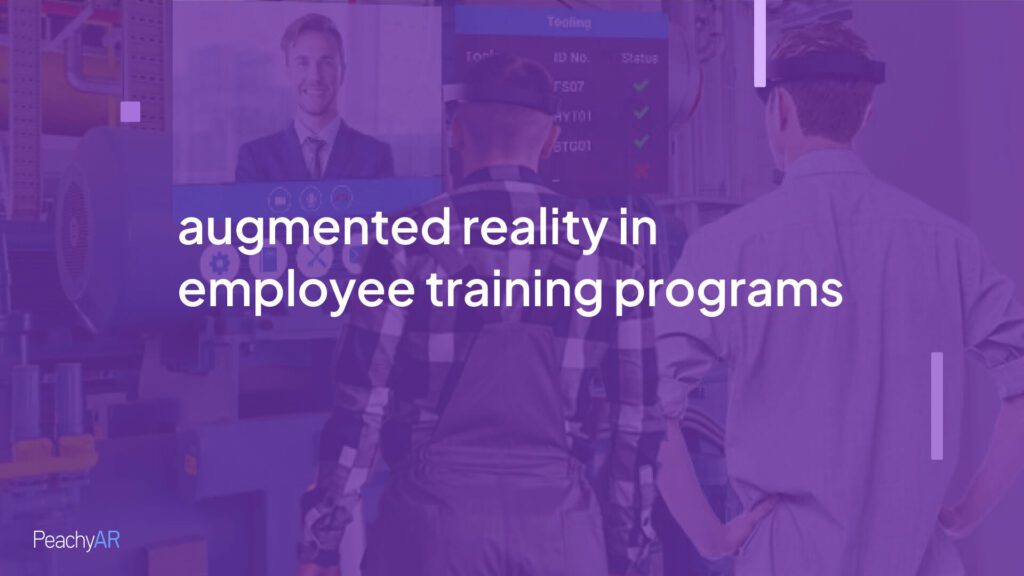Companies may miss significant benefits if augmented reality (AR) is not incorporated into employee training programs!! Why?
Augmented reality (AR) is a rapidly advancing technology that has the potential to revolutionize various industries, including employee training programs. By overlaying digital information in the real-world environment, AR can create highly engaging and interactive experiences that can significantly enhance the effectiveness of employee training. In this blog post, we will explore how augmented reality can be used to improve employee training programs. Find out more about The future of Augmented Reality in Businesses.
AR technology adds a layer of virtual information to the real world, providing employees with immersive and interactive experiences. Training can become monotonous and less engaging without AR, decreasing motivation and knowledge retention. AR allows employees to learn through hands-on experiences, simulations, and interactive scenarios, boosting their comprehension and skills development. Additionally, AR-based training programs foster a safe environment for employees to make mistakes and learn from them without real-world consequences. By neglecting AR in training, companies may restrict this technology’s potential for innovation, efficiency, and productivity enhancement.

Augmented Reality in employee training programs:
– Leadership development: This program focuses on enhancing leadership skills such as communication, decision-making, and team management.
– Customer service training: This program aims to improve employees’ ability to provide exceptional customer service by teaching active listening, empathy, and conflict resolution skills.
– Sales training: This program focuses on equipping employees with the knowledge and skills required for effective sales techniques, including prospecting, handling objections, and closing deals.
– Time management: This program helps employees develop efficient time management skills, enabling them to prioritize tasks, set goals, and work more effectively.
– Communication skills: This training program aims to improve employees’ verbal and written communication skills, including active listening, effective presentation, and professional writing.
– Online safety training: This program teaches employees about online safety practices, including protecting sensitive data, recognizing phishing attempts, and safeguarding personal information.
– Diversity and inclusion training: This program aims to cultivate an inclusive workplace by promoting understanding, respect, and acceptance of individual differences in ethnicity, gender, religion, and other key areas.
– Compliance training: This program educates employees about company policies, legal requirements, and industry regulations to ensure ethical and legal standards adherence.
– Conflict resolution: This training program equips employees with skills to manage and resolve conflicts effectively, fostering a harmonious and productive work environment.
– Stress management: This program helps employees identify and manage stressors, offering techniques to reduce stress and improve overall well-being.
– Project management: This training program focuses on equipping employees with essential project management skills such as planning, organizing, and executing projects efficiently.
– Presentation skills: This program helps employees enhance their ability to deliver effective presentations, including organizing content, engaging the audience, and utilizing visual aids.
– Team building: This training program emphasizes the importance of teamwork and collaboration, fostering stronger relationships and enhancing team productivity.
– Personal development: This program focuses on nurturing personal growth by developing goal-setting, self-motivation, and problem-solving skills.
This is how AR helps you enhance employee training programs
1. Enhanced learning experiences:
AR can provide employees with a more immersive and interactive training experience than traditional methods. Employees can visualize and practice real-life scenarios in a simulated environment using AR devices such as smart glasses or mobile devices. For example, employees in the healthcare industry can gain hands-on experience in performing medical procedures without the need for direct patient interaction.
2. On-the-job training:
AR can be particularly beneficial for on-the-job training, where employees can directly apply their skills in real-time. With AR, employees can access relevant information and guidance at the point of need, improving their efficiency and reducing the risk of errors. For instance, technicians can use AR to access equipment maintenance procedures or troubleshoot issues, enhancing productivity and reducing downtime.
3. Gamification of training:
AR can make employee training more engaging by introducing gamification elements. AR-based training programs can transform mundane tasks into enjoyable activities through interactive challenges, quizzes, and simulations, increasing motivation and knowledge retention. Gamification can also foster healthy employee competition and collaboration, improving their overall performance.
4. Remote and distributed training:
AR can bridge geographical gaps and make training accessible to employees across different locations. With AR-enabled devices, trainers can conduct remote training sessions and provide real-time guidance and support to employees worldwide. This eliminates the need for costly and time-consuming travel, making training programs more flexible and efficient.
5. Safety training:
AR is particularly valuable in high-risk industries where safety is paramount. By simulating hazardous scenarios, AR can help employees develop critical safety skills without exposing them to real dangers. For example, oil and gas industry workers can experience virtual simulations of emergencies or accidents, allowing them to practice appropriate responses and enhance their emergency preparedness.
6. Soft skills development:
Augmented reality can also enhance the development of soft skills, such as customer service, leadership, and communication. AR can help employees practice interpersonal skills in a safe and controlled environment by presenting them with realistic virtual scenarios. Feedback and performance metrics provided by the AR system can further improve self-awareness and improve skills.

What are the benefits of incorporating augmented reality into employee training?
– Enhanced engagement: Augmented reality brings a new level of interactivity to training, making it more engaging for employees. It helps to keep their interest and attention throughout the training program.
– Real-time feedback: Augmented reality allows trainers to provide immediate feedback to employees on their performance. This lets them quickly correct and learn from mistakes, leading to faster skill development.
– Hands-on experience: By incorporating augmented reality, employees can gain practical experience in a simulated environment. This helps them to learn by doing and makes training more effective.
– Cost-effective: Augmented reality eliminates the need for physical training equipment and resources, saving costs associated with traditional training methods. It reduces the need for travel and accommodation expenses as well.
– Increased retention: Research has shown that augmented reality can improve information retention compared to traditional training methods. The immersive nature of augmented reality helps employees retain knowledge and skills for longer periods.
– Risk-free learning: Augmented reality provides a safe learning environment for employees to practice skills without real-life consequences. It allows them to make mistakes and learn from them, avoiding any potential risks associated with on-the-job training.
– Flexibility and accessibility: With augmented reality, training can be conducted anytime and anywhere, allowing employees to learn at their own pace. It can also be accessed remotely, delivering training to a larger audience.
– Customizable and scalable: Augmented reality allows customized training programs to meet the specific needs of different job roles or skill levels. It can also be easily scaled to accommodate a growing number of employees.
– Increased efficiency: By incorporating augmented reality into training, employees can learn more efficiently and effectively. The hands-on experience, real-time feedback, and engaging elements lead to faster skill acquisition and increased productivity.
PeachyAR: your solution to enhance employee training programs
Additionally, augmented reality training can be customized to each employee’s learning style and pace, ensuring a more effective and personalized learning experience.
Take your employee training programs to the next level with PeachyAR! Our innovative solution is designed to enhance training experiences and improve employee engagement. Don’t miss out on this opportunity to try PeachyAR for free. Sign up today for a no-obligation trial and see the incredible results for yourself. Don’t wait; harness the power of augmented reality to revolutionize your training programs. Sign up now and unleash the full potential of your workforce!





